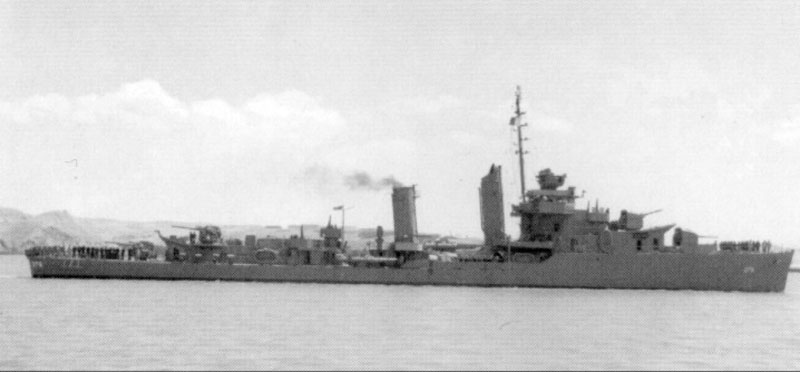
Cushing III(DD-376: dp. 1,500; L. 341'4"; b. 35'; dr. 9'10"; s.36 k.; cpl. 168; a. 5 5", 12 21" tt.; cl. Dale)
The third Cushing was launched 31 December 1936 by Puget Sound Navy Yard; sponsored by Miss K. A. Cushing, daughter of Command Cushing; commissioned 28 August 1936, Commander E. T. Short in command; and reported to the Pacific Fleet.
Cushing joined the search in the Hawaiian Islands and at Howland Island, for the missing aviatrix Amelia Earhart from 4 to 30 July 1937, then returned to San Diego for training exercises, tactics, and fleet problems. Except for brief periods of training at Pearl Harbor and one cruise to the Caribbean, she cruised the west coast from San Diego for exercises and training.
Undergoing overhaul at Mare Island Navy Yard when the Japanese struck Pearl Harbor, Cushing sailed from San Francisco 17 December 1941 for convoy escort duty between the west coast and Pearl Harbor until 13 January 1942. She sailed to Midway to serve on antisubmarine patrol from 18 January to 2 February, then returned to San Francisco 19 February to screen TF 1 off the California coast in training and patrol duty.
On 1 August 1942 Cushing departed San Francisco for training exercises at Pearl Harbor, then to join the operations around Guadalcanal. Constantly on the move, she escorted vital resupply convoys to the bitterly contested island, and fought in the Battle of Santa Cruz of 26 October, when an outnumbered American force turned a Japanese flotilla back from their advance toward Guadalcanal.
Cushing screened transports safely into Guadalcanal 12 November 1942 and was in the van of the force that moved out to intercept the Japanese fleet in the Naval Battle of Guadalcanal on the night of 13 November. As the range closed, she suddenly sighted three enemy destroyers at 3,000 yards. In the bitter gunfire which followed Cushing received several hits amidships, resulting in a gradual power loss, but she determinedly continued to fire her guns at the enemy, launching her torpedoes by local direction at an enemy battleship. Fires, exploding ammunition, and her inability to shoot any longer made the abandon ship order unavoidable at 0230. Her burning hulk was last seen from Guadalcanal at 1700 when she sank about 3,500 yards southeast of Savo Island. Cushing lost about 70 men killed or missing, some of them later rescued from the water, and many wounded, but with the task force she had aided in saving Henderson Field from a
disastrous bombardment by a Japanese force.Cushing received three battle stars for World War II service.
From the The Dictionary of American Naval Fighting Ships (DANFS)
Additional links;
The Last days of the USS Cushing DD376 Nov. 1942 by George E. Burghardt